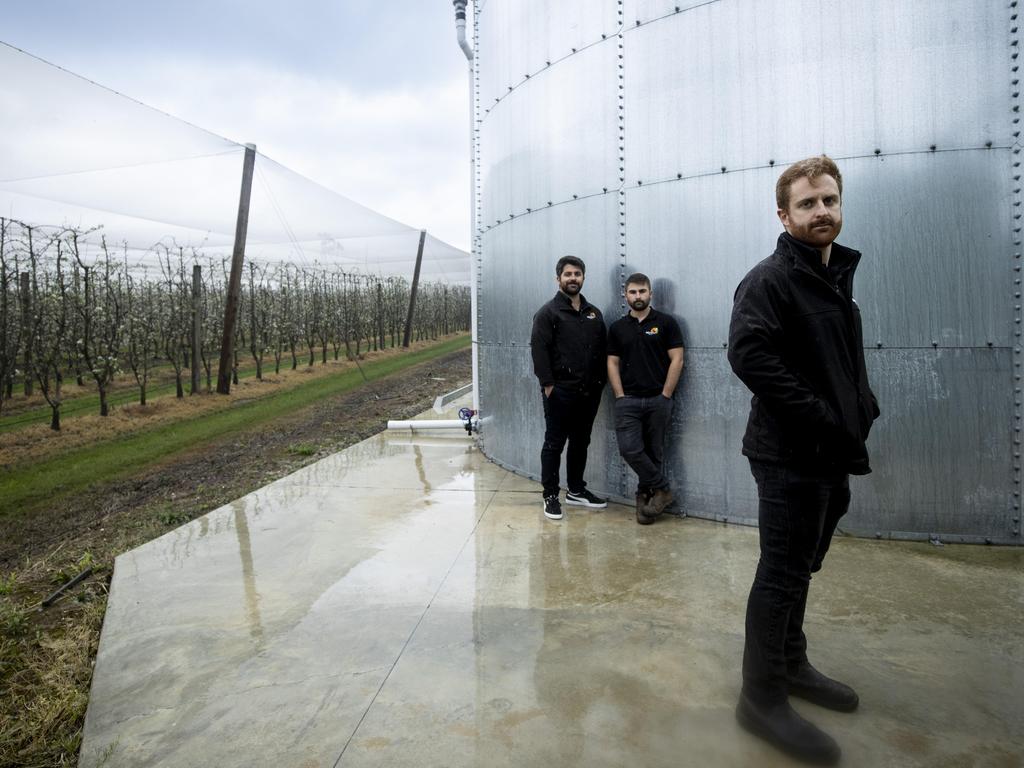Swiftness of moisture-sapping El Nino catches farmers off guard
First came the drought, then low livestock prices, then the fires. It’s created a nightmare scenario in the bush that only the weather can solve.

There was more than water in the 21mm of rain that fell over Dean Missingham’s cattle stud on Queensland’s Darling Downs last weekend. The rolling storms brought with them a brief sense of relief and halted the free fall of cattle prices at the state’s saleyards.
It was far from a deluge, but across two days the clouds delivered almost as much as the paltry 35mm the Missingham family farm had received in the past six months. “The rain we had on the weekend was great,” Missingham tells Inquirer. “But we do need some follow-up.”
It’s a lament muttered throughout drought-affected parts of Queensland and NSW crying out for a genuine reprieve from the effects of a bitter El Nino weather system.
The rain that fell over much of eastern Australia last week soaked parched paddocks, replenished empty rainwater tanks and doused dozens of fires burning through tinder dry farmland and forests. The showers were more than welcome but a fraction of what is needed. For many inhabitants of rural Australia, where life is governed by the weather, it’s almost beyond belief that they could be in this situation so quickly after a year of flooding rain and three of the best seasons on record.
It was always expected that things would dry out eventually, as they have done with regularity for as long as records have been kept. But it’s the suddenness with which the rain-giving La Nina was replaced by moisture-sapping El Nino that caught so many farmers off guard.
“It turned so dry so quickly,” Missingham says. “We had a really wet winter and spring last year but it was cold so nothing really grew. Then it dried out and as soon as it got hot there was no moisture to help it grow.”
Farmers, who after years of destocking during the last stretch of drought (2017-20) had embarked on a massive nationwide restocking phase, were suddenly left with paddocks full of sheep and cattle but rapidly diminishing feed.
As pastures declined, hay prices skyrocketed. In Queensland a tonne of hay now can cost between $500 and $750, up from about $250. Pre-emptively, then out of necessity, farmers began to sell, flooding the market and sending prices tumbling.
The influence of rain on the decision-making process of primary producers is best demonstrated by analysis of the market.
The Eastern States Young Cattle Indicator, a rolling average of young cattle prices, rose from 366c a kilogram last Saturday when the rain began to fall to 399c on Thursday – the first substantial rise in price this year, but still well down from 1019c a year ago.
Stock numbers going through saleyards dropped significantly, particularly in areas that recorded rain as farmers chose to hold on in hope of a better season.
Like most farmers, the Missingham family anticipated the drought and took steps to prepare.
They installed a centre-pivot irrigation system on their farm to grow oats and forage sorghum for their cattle and set up a stockfeed business. It provided a lifeline for the family’s carefully bred herd of Speckle Park cattle.
“We’re pretty fortunate that we’re in a position where we don’t have to sell, and we’re trying to ride it out,” Missingham says. “But anything we do sell is fat because of the silage and stock feed and grain ration, so we’re able to take advantage of the slightly better prices for fat cattle.”
Fortunately, after three years of good rain, the farm’s groundwater bores are still running strong and the springs that feed the farm’s dams dried up only in the past few months. “There’s still plenty of moisture down low from the big wets we had in 2021, 2022,” Missingham says.
“It doesn’t seem as dire as 2019 and we invested heavily since the last drought to make sure that we were somewhat shielded from it. But you can never really say that because you still don’t know what’s coming.”
Driest October
on record
From August to October the national rainfall level was 61.2 per cent below average, making it the country’s driest three-month period since records began in 1900, according to the Bureau of Meteorology. It was particularly acute in southern Queensland, northeastern NSW, patches of South Australia, the Northern Territory and Western Australia, thanks to the twin effects of El Nino and the positive Indian Ocean Dipole. Victoria was the only state not to record below average rainfall last month.

In the usually lush Gympie region in Queensland’s Sunshine Coast hinterland, just 0.4mm of rain fell in October, a long way below the month’s average of 72mm. Even in towns not far west of Noosa, such as Cooroy and Pomona, rural landowners reliant on consistent rain ran out of drinking water, sparking a frenzy for water delivery services and creating waiting lists several weeks long.
River and creek flows in affected areas have dropped significantly, but most spring-fed dams remain intact thanks to abundant rain stored in the water table during the past few years.
The summer outlook is hardly promising, although southern Queensland and NSW have a chance of exceeding median rainfall. Beyond that the outlook is even less certain, but many farmers are expecting to be in for a few dry seasons ahead.
“It’s almost like we’re going to see a line that separates those who are having a better time versus those people who are having a tough time, and that’s likely to run through Orange (NSW),” says John Warlters, chief executive of charity organisation Rural Aid.
“If you’re above that line, things are going to be tight and tough; if you’re below it, you’re probably having a better time and enjoying some of the rainfall that other parts haven’t been receiving.” Rural Aid has been swamped with calls from people living in rural areas, seeking counselling or help feeding their stock. Demand for the counselling service has doubled in the past year, driven by the rapid deterioration of the season and low livestock prices.
Warlters is pleased that the callers are willing to seek help, but he wishes there was no need.
“It’s starting to get back to 2018-19 levels really quickly,” he says. “We provided farmers with about $50m worth of hay over those two years.”
Since June 1, Rural Aid has delivered about 3000 bales of hay, weighing a total of 1200 tonnes, to farmers under its Buy a Bale charity campaign.
Fuel to the fire
The fodder drops increased significantly with the onset of spring as the temperature warmed and fires raged through the dried-out bush.
It’s rare for fires to burn so fiercely in early spring, but a combination of low rainfall and high temperatures created conditions ripe for fuelling the blazes.
Hundreds of fire fronts burned throughout Queensland during the past few weeks, destroying precious pastures preserved by farmers to get them through the hot summer.
AgForce estimates more than 270,000ha were razed in central Queensland and about 50,000ha in the Burnett region, northwest of Brisbane. Around Dalveen, near Stanthorpe on the Queensland-NSW border, about 10,000ha was burnt.
“These fires have been very fast moving and have destroyed a lot of dry feed for our stock, which leaves people in that difficult position with animals and very few feed options,” AgForce president Georgie Somerset says. “And unfortunately because of the season we’ve had, there’s not a lot of available feed in the area either.”

The loss of pasture has created a dire situation for affected farmers. Some abattoirs scheduled extra shifts to make room for cattle coming in from burnt-out properties and governments organised fodder drops for stock to give producers time to come up with alternative plans.
Rural Aid, on behalf of the Queensland government, has delivered a further 360 bales of hay to farmers who lost their feed to the flames.
Dozens of fires have burnt through millions of hectares in the Northern Territory and threatened the grassy plains of the Barkly Tableland where farmers had finally replenished their pastures after years of drought. An estimated 13 million hectares have burned throughout the Territory.
“It’s pretty devastating, finally getting grass and then losing it to fire, and losing that ground cover early in the season,” National Farmers Federation president David Jochinke says. He says the rapid shift between wet and dry conditions caught most producers unaware.
“It’s really hard, when you’ve gone from massive floods to crippling droughts in the space of a few years, to get your plan fully in place,” Jochinke says. “Unfortunately, a lot of producers are in that position where they’ve taken some actions but weren’t where they wanted to be yet.”

Central Queensland grazier Adam Coffey, who is also the acting chief executive of Cattle Australia, fought to save his own valuable pasture from a fire last week.
“We pulled it up, but there are a lot of properties there that got completely burnt out,” Coffey says.
“When you can’t sell your cattle for a lot, and then there’s no agistment options to put them elsewhere because everybody’s relatively short on grass due to the dry, it’s really tough.”
Coffey says although drought is certainly biting in some regions, the industry needs to be careful not to panic. “(After the 2019 drought) we bounced back pretty quickly over the last couple of good years, but that drought is still fresh in people’s memories,” he says.
“Producers are being very gun shy and they pulled the trigger very early on destocking, which is a good thing because that’s how we protect our land and manage these dry times … but the pessimistic forecasts have probably not helped the situation.
“We’ve got to be aware that there’s a line where negativity breeds negativity and it creates a bit of panic selling and oversupply.”
Government support has been made available to people living within the drought and fire zones, including $250,000 loans for primary producers in Queensland and $5000 subsidies for freight costs for stock, fodder and equipment.
Asked whether he expects the organisation will have a busy few years ahead, Rural Aid chief Warlters says indications are that it is likely. “(Bureau of Meteorology) mapping shows soil moisture levels in a huge part of Queensland, NSW and over in WA is a pulsating red because it is the lowest on record,” he says. “But it’s also mapping out those same areas that were at the epicentre of the last drought and here we are again, with all these bigger factors sitting over the top of that from a season and climate perspective.
“With that sort of evidence, you can’t not think that things unfortunately will get worse before they get better. We hope like hell that’s not the case, and we don’t want to be merchants of doom and gloom, but we also want to make sure that we’re ready and able to help those people who are living through it right here and now.”





To join the conversation, please log in. Don't have an account? Register
Join the conversation, you are commenting as Logout